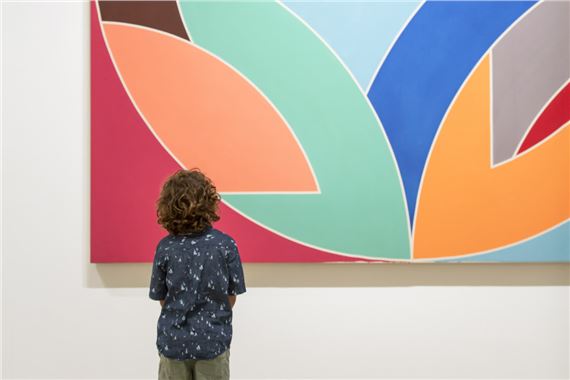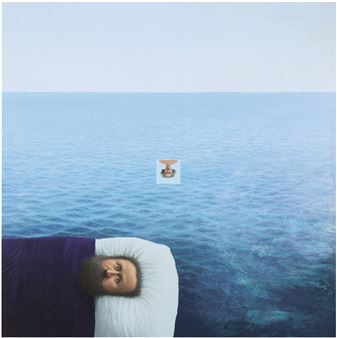American Minimal
This installation pays tribute to a passing generation of Minimalist artists, most notably Frank Stella (1936ŌĆō2024). Highlighting the MuseumŌĆÖs major Stella, Flin Flon VIII (1970), the selection includes a broad range of work from diverse media, many of which have not been on view before.
Minimalism was both an extension and a rejection of Abstract Expressionism, furthering its commitment to nonrepresentation, while also moving away from broad gestures and brushstrokes to remove any trace of the hand of the artist. With Minimalism, no attempt is made to imitate reality; rather the work presents a new realityŌĆöthat of the object as it is. The movement began in 1959 when Stella exhibited his Black Paintings at New YorkŌĆÖs Museum of Modern Art. The crisp geometric white lines on black backgrounds of these works are repeated in the 1967 lithograph Tuxedo Park displayed here. Stella once quipped to a journalist, ŌĆ£What you see is what you see,ŌĆØ a statement that became the movementŌĆÖs unofficial motto.
By focusing on the objectives to free art from representation and to remove the historical predominance of the artist as creator, Minimalism aimed to make contemporary art more egalitarian. Its aesthetics of simplicity, repetition, order, harmony, and truthŌĆönot trying to be other than what it isŌĆöcontinued to impact succeeding generations of artists working with industrial fabrication, sound, light, weight, and balance, as well as new materials and technologies.
In this installation James Hyde and Louise Nevelson experiment with resin and Perspex, while John Cage, Nancy Haynes, and Jay Kelly employ simple repetitive markings evocative of mathematics, music, and early computer-generated art. Artists working in Southern California as part of the related Light and Space movement, including John McCracken and DeWain Valentine, focus on perceptual phenomena and incorporate the latest technologies of local engineering and aerospace industries to develop light-filled objects. Photographs by Arnold Newman vividly document the broader Minimalist culture concurrent in the visual arts, music, and dance.

Recommended for you
This installation pays tribute to a passing generation of Minimalist artists, most notably Frank Stella (1936ŌĆō2024). Highlighting the MuseumŌĆÖs major Stella, Flin Flon VIII (1970), the selection includes a broad range of work from diverse media, many of which have not been on view before.
Minimalism was both an extension and a rejection of Abstract Expressionism, furthering its commitment to nonrepresentation, while also moving away from broad gestures and brushstrokes to remove any trace of the hand of the artist. With Minimalism, no attempt is made to imitate reality; rather the work presents a new realityŌĆöthat of the object as it is. The movement began in 1959 when Stella exhibited his Black Paintings at New YorkŌĆÖs Museum of Modern Art. The crisp geometric white lines on black backgrounds of these works are repeated in the 1967 lithograph Tuxedo Park displayed here. Stella once quipped to a journalist, ŌĆ£What you see is what you see,ŌĆØ a statement that became the movementŌĆÖs unofficial motto.
By focusing on the objectives to free art from representation and to remove the historical predominance of the artist as creator, Minimalism aimed to make contemporary art more egalitarian. Its aesthetics of simplicity, repetition, order, harmony, and truthŌĆönot trying to be other than what it isŌĆöcontinued to impact succeeding generations of artists working with industrial fabrication, sound, light, weight, and balance, as well as new materials and technologies.
In this installation James Hyde and Louise Nevelson experiment with resin and Perspex, while John Cage, Nancy Haynes, and Jay Kelly employ simple repetitive markings evocative of mathematics, music, and early computer-generated art. Artists working in Southern California as part of the related Light and Space movement, including John McCracken and DeWain Valentine, focus on perceptual phenomena and incorporate the latest technologies of local engineering and aerospace industries to develop light-filled objects. Photographs by Arnold Newman vividly document the broader Minimalist culture concurrent in the visual arts, music, and dance.
Contact details


 ARTISTS
ARTISTS















